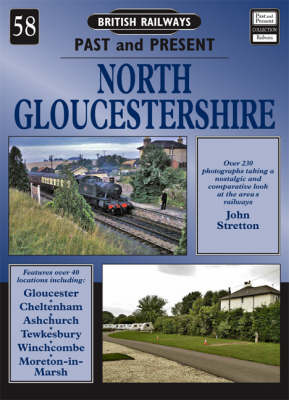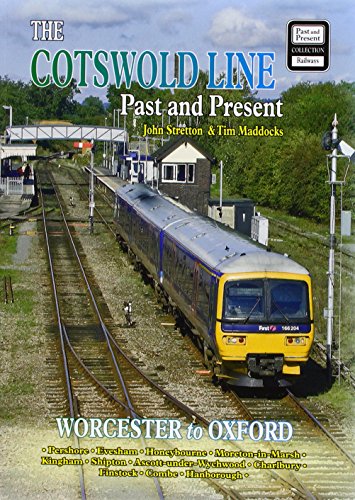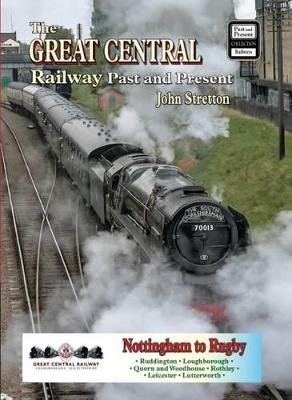British Railways Past & Present S.
2 primary works • 5 total works
Book 55
This title talks about: former GWR main lines from Banbury to Oxford and Didcot and towards Ashendon; the Bristol main line between Cholsey and Steventon, added to the county in 1974; the King's Sutton-Kingham cross-country route; the old Oxford, Worcester and Wolverhampton route in the county; the Woodstock and Faringdon branches, and the Fairford branch as far as Kelmscott; the former LNWR line into Oxford (Rewley Road); and the railway complex at Oxford.
Book 58
Contains photographs of the same railway location separated in time by just a few years, or maybe a century or more. This title includes Gloucester Central, Ledbury Branch, Cheltenham to Stow-on-th-Wold, and Moreton-in-Marsh.
Using a rare collection of archive photographs, 'past and present' regular John Stretton describes the old M&SWJR route from Andoversford to Marlborough, via Cirencester and Swindon, concentrating on the achievements and developments at Blunsdon as the S&CR strives to expand north and south towards the towns of its title.
Authorised in 1845 and opened in stages between 1852 and 1853, the Oxford, Worcester and Wolverhampton Railway (OWW) built the line from Wolvercot Junction, north of Oxford station, to Worcester and Wolverhampton, via Stourbridge and Dudley, with Isambard Kingdom Brunel as the chief engineer. After a rather chequered history, and colloquially known as the 'Old, Worse and Worst' railway, the length between Oxford and Worcester was inherited by British Railways in 1948. More latterly known as the North Cotswold Line, it was singled in places in 1971, with a view to cutting costs, leaving just 11 miles of double track out of the 51-mile length of the route. With passenger numbers holding up and the birth and growth of the the Cotswold Line Promotion Group, that urged development, Network Rail began assessing the possibilities in 2006 of addressing the capacity restraints.
The 'Cotswold Redoubling Project', GBP70 million scheme to restore a total of 21 miles of double track between Evesham and Charlbury, saw preparatory work undertaken during 2009, including major work in and around Chipping Campden Tunnel, with removal of old material, a new drain installed and a second track laid in readiness for the later part of the Project. Elsewhere, approaching ten miles of track was repositioned, to enable a second line to be installed; thirty miles of new cabling was installed; and sixty sets of signal equipment relocated. 2010 saw a number of possessions, as preparatory work continued, including making ready the various level crossings between Evesham and Moreton-in- Marsh; attention to an overbridge just south of Evesham station; and, over the weekend of 2/3 October a major achievement with the replacement of the existing single line bridge east of Honeybourne by a brand new double width version.
2011 saw second platforms being returned to Honeybourne, Ascottunder- Wychwood and Charlbury; enhancements to passenger facilities at most of the stations en-route; the freight line to Long Marston from Honeybourne realigned; a re-instatement of a group of sidings by Honeybourne station; and provision for the eventual northern extension of the Gloucestershire Warwickshire Steam Railway to pass under the Cotswold line, to gain access to a new platform face at Honeybourne. The long campaign from the Cotswold Line Promotion Group, local authorities and individuals has borne fruit, with an increase in the numbers of trains servicing the route, further enhancing the travelling experience and giving the line a long term future. This volume looks at these newer works against a backdrop of past operations, including views of the engineering works involved and provides a fascinating exhibition of the evolving history.
The 'Cotswold Redoubling Project', GBP70 million scheme to restore a total of 21 miles of double track between Evesham and Charlbury, saw preparatory work undertaken during 2009, including major work in and around Chipping Campden Tunnel, with removal of old material, a new drain installed and a second track laid in readiness for the later part of the Project. Elsewhere, approaching ten miles of track was repositioned, to enable a second line to be installed; thirty miles of new cabling was installed; and sixty sets of signal equipment relocated. 2010 saw a number of possessions, as preparatory work continued, including making ready the various level crossings between Evesham and Moreton-in- Marsh; attention to an overbridge just south of Evesham station; and, over the weekend of 2/3 October a major achievement with the replacement of the existing single line bridge east of Honeybourne by a brand new double width version.
2011 saw second platforms being returned to Honeybourne, Ascottunder- Wychwood and Charlbury; enhancements to passenger facilities at most of the stations en-route; the freight line to Long Marston from Honeybourne realigned; a re-instatement of a group of sidings by Honeybourne station; and provision for the eventual northern extension of the Gloucestershire Warwickshire Steam Railway to pass under the Cotswold line, to gain access to a new platform face at Honeybourne. The long campaign from the Cotswold Line Promotion Group, local authorities and individuals has borne fruit, with an increase in the numbers of trains servicing the route, further enhancing the travelling experience and giving the line a long term future. This volume looks at these newer works against a backdrop of past operations, including views of the engineering works involved and provides a fascinating exhibition of the evolving history.
The Great Central Railway was built in 1899, with the intention of providing journeys from Manchester to the Continent through a projected Channel Tunnel. It was a scheme of grand pride and vision. The history of the line is one of gradual reduction in scope, ambition and achievement, with inherent post-War UK problems leading to the removal of the Manchester and Sheffield routes to Nottingham. The 1950s saw reductions and decline, with the removal of prestigious named trains 'The South Yorkshireman' and 'The Master Cutler', together with the final ignominy of transfer from ex-LNER to ex-LMS control at the end of the 1950s. The Derby empire did not see the need for this railway, duplicating, as they saw it, their existing routes from Nottingham-London and the GCR was further truncated, removing local services in the early 1960s, the through route to London in 1966 and closure of the final rump, from Nottingham (Ruddington)-Rugby, in 1969.
The ending of steam on the through route in 1966 led to preservationists becoming interested and through the 1970s and beyond, the sections from Ruddington to Loughborough and Loughborough to Leicester North have been re-opened and developed, to create the only main line double track private railway in the UK. There are plans - grandiose and hugely ambitious to close the gap between the two ends at Loughborough, which will truly give travellers a recreation of some of the appeal of the lost line. This volume looks at the past views between Nottingham (Victoria) and Rugby (Central) stations, with many present day scenes to contrast and compare and closes with a section looking at some of the scenes that have accompanied the progress by the restorationists over the past 40 years. The achievements of the present day Great Central Railway have been impressive, with the promise of even greater things to come.
The ending of steam on the through route in 1966 led to preservationists becoming interested and through the 1970s and beyond, the sections from Ruddington to Loughborough and Loughborough to Leicester North have been re-opened and developed, to create the only main line double track private railway in the UK. There are plans - grandiose and hugely ambitious to close the gap between the two ends at Loughborough, which will truly give travellers a recreation of some of the appeal of the lost line. This volume looks at the past views between Nottingham (Victoria) and Rugby (Central) stations, with many present day scenes to contrast and compare and closes with a section looking at some of the scenes that have accompanied the progress by the restorationists over the past 40 years. The achievements of the present day Great Central Railway have been impressive, with the promise of even greater things to come.




